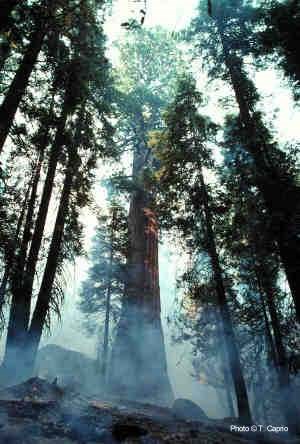
NPS Photo Pre- and post-burn tree mortality rates, size structure, basal area and ingrowth were determined for four 1.0 hectare mixed conifer forest stands in the Log Creek and Tharp's Creek watersheds of Sequoia National Park. Mean annual mortality between 1986 and 1990 was 0.8% for both watersheds. In the fall of 1990, the Tharp's Creek watershed was treated with a prescribed burn. Between 1991 and 1995, mean annual mortality was 1.4% in the unburned Log Creek watershed and 17.2% in the burned Tharp's Creek watershed. A drought from 1987 to 1992 likely contributed to the mortality increase in the Log Creek watershed. The high mortality in the Tharp's Creek watershed was primarily related to crown scorch from the 1990 fire and was modeled with logistic regression for white fir (Abies concolor (Gord. and Glend.)) and sugar pine (Pinus lambertiana (Dougl.)). From 1989 to 1994, basal area declined an average of 5% per year in the burned Tharp's Creek watershed, compared to average annual increases of less than 1% per year in the unburned Log Creek watershed and in the Tharp's watershed prior to burning. Post-burn size structure was dramatically changed in the Tharp's stands: 75% of trees <50 cm and 25% of trees >50 cm were killed by the fire. |
Last updated: March 1, 2015
